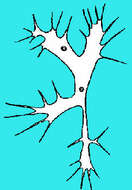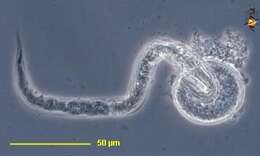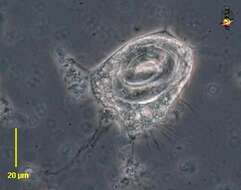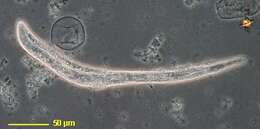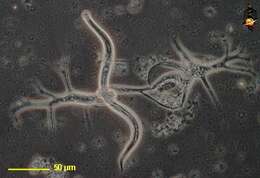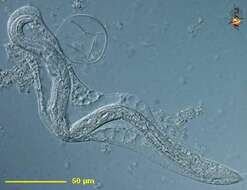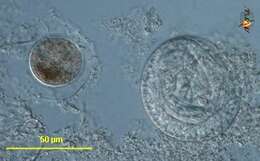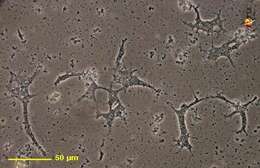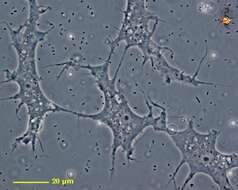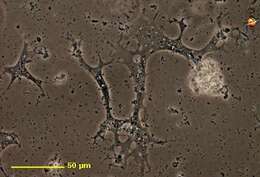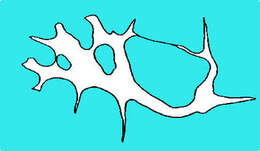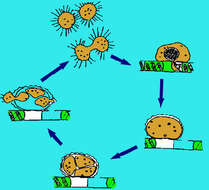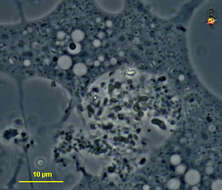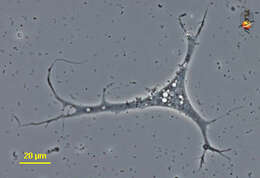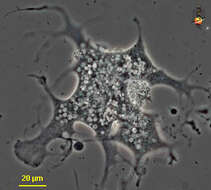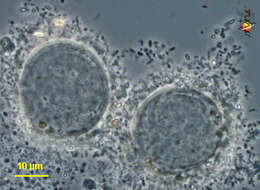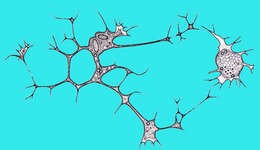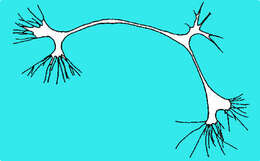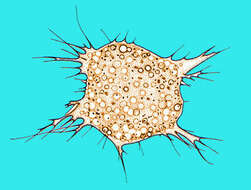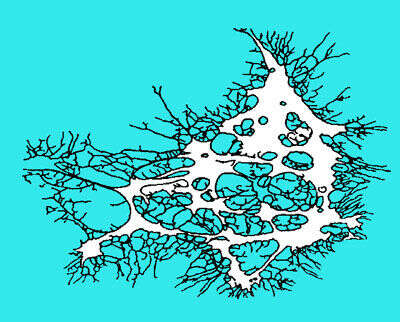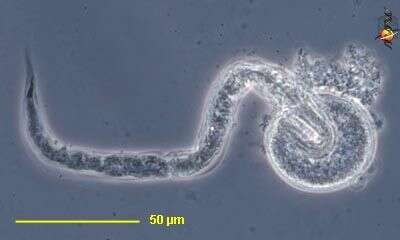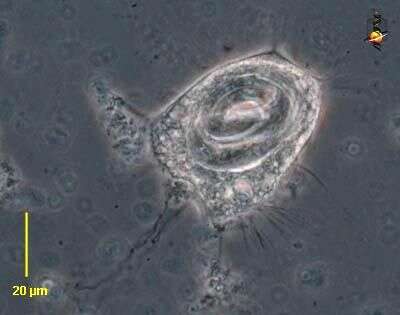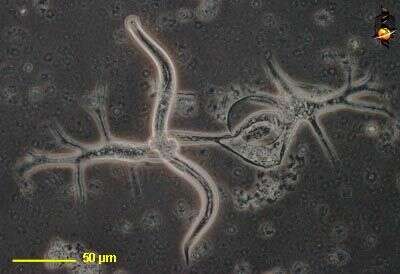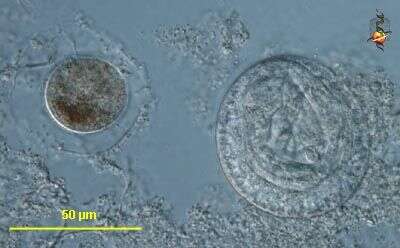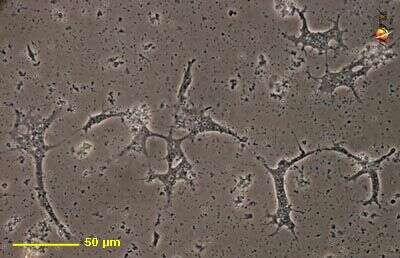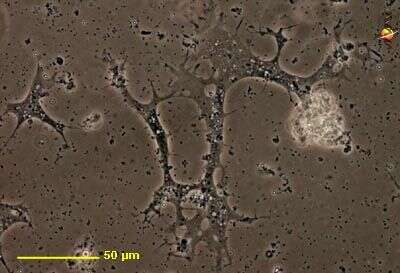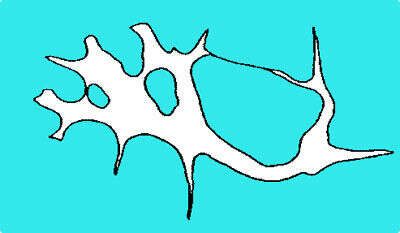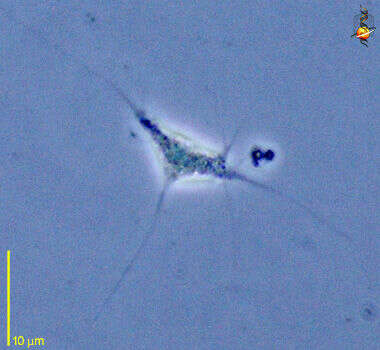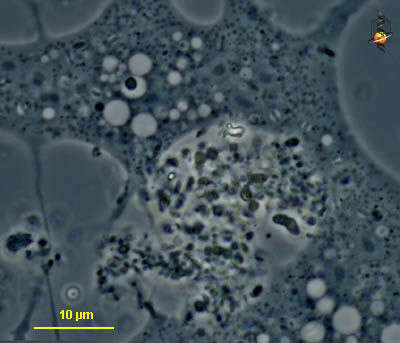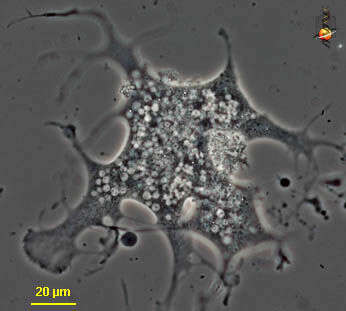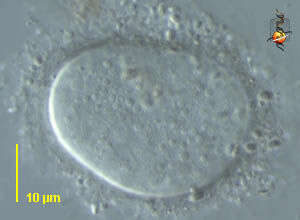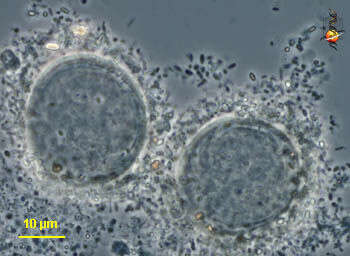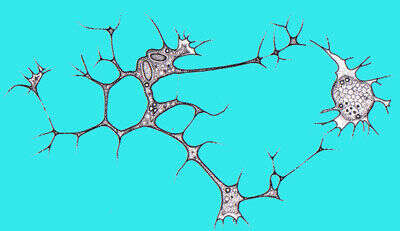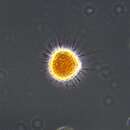-
-
-
Theratromyxa (thee-rat-row-mix-a) is a rarely reported large amoeba from soils. The organism may adopt an extended form with masses of cytoplasm separated from other masses by finer cytoplasmic strands. There are multiple nuclei and the impression is that these organisms can extend over many millimeters or centimetres. This strain eats nematodes. They are first caught with pseudopodia . The food is then enclosed within a food vacuole, packed tightly and digested. The amoeba often encysts during this process or slightly afterwards. Such cysts are referred to as digestion cysts are are not suited for protection from drying out. The amoebae excyst to embark on another food expedition. An empty cyst and the residue of a meal is shown here. Phase contrast.
-
Theratromyxa (thee-rat-row-mix-a) is a rarely reported large amoeba from soils. The organism may adopt an extended form with masses of cytoplasm separated from other masses by finer cytoplasmic strands. There are multiple nuclei and the impression is that these organisms can extend over many millimeters or centimetres. This strain eats nematodes. They are first caught with pseudopodia . The food is then enclosed within a food vacuole, packed tightly - as illustrated here - , and digested. The amoeba often encysts during this process or slightly afterwards. Such cysts are referred to as digestion cysts are are not suited for protection from drying out. The amoebae excyst to embark on another food expedition. An empty cyst is evident above the amoeba and its food. Phase contrast.
-
Theratromyxa (thee-rat-row-mix-a) is a rarely reported large amoeba from soils. The organism may adopt an extended form with masses of cytoplasm separated from other masses by finer cytoplasmic strands. There are multiple nuclei and the impression is that these organisms can extend over many millimeters or centimetres. This strain eats nematodes. They are first caught with pseudopodia . The food is then enclosed within a food vacuole - as illustrated here - packed tightly, and digested. The amoeba often encysts during this process or slightly afterwards. Such cysts are referred to as digestion cysts are are not suited for protection from drying out. The amoebae excyst to embark on another food expedition. An empty cyst is evident above the amoeba and its food. Phase contrast.
-
Theratromyxa (thee-rat-row-mix-a) is a rarely reported large amoeba from soils. The organism may adopt an extended form with masses of cytoplasm separated from other masses by finer cytoplasmic strands. There are multiple nuclei and the impression is that these organisms can extend over many millimeters or centimetres. This strain eats nematodes. They are first caught with pseudopodia - as is illustrated here,. The food is then enclosed within a food vacuole, packed tightly, and digested. The amoeba often encysts during this process or slightly afterwards. Such cysts are referred to as digestion cysts are are not suited for protection from drying out. The amoebae excyst to embark on another food expedition. Phase contrast.
-
Theratromyxa (thee-rat-row-mix-a) is a rarely reported large amoeba from soils. The organism may adopt an extended form with masses of cytoplasm separated from other masses by finer cytoplasmic strands. There are multiple nuclei and the impression is that these organisms can extend over many millimeters or centimetres. This strain eats nematodes. They are first caught with pseudopodia . The food is then enclosed within a food vacuole - as illustrated here - packed tightly, and digested. The amoeba often encysts during this process or slightly afterwards. Such cysts are referred to as digestion cysts are are not suited for protection from drying out. The amoebae excyst to embark on another food expedition. Differential interference contrast.
-
Theratromyxa (thee-rat-row-mix-a) is a rarely reported large amoeba from soils. The organism may adopt an extended form with masses of cytoplasm separated from other masses by finer cytoplasmic strands. There are multiple nuclei and the impression is that these organisms can extend over many millimeters or centimetres. This strain eats nematodes. They are first caught with pseudopodia . The food is then enclosed within a food vacuole, packed tightly , and digested. The amoeba often encysts during this process or slightly afterwards. Such cysts are referred to as digestion cysts are are not suited for protection from drying out. This picture shows a digestion cyst to the right and another more compact cyst to the left. The amoebae excyst to embark on another food expedition. An empty cyst is evident above the amoeba and its food. Differential interference contrast.
-
Theratromyxa (thee-rat-row-mix-a) is a rarely reported large amoeba from soils. The organism may adopt an extended form with masses of cytoplasm separated from other masses by finer cytoplasmic strands. There are multiple nuclei and the impression is that these organisms can extend over many millimeters or centimetres. This strain eats nematodes. They are first caught with pseudopodia . The food is then enclosed within a food vacuole, packed tightly, and digested. The amoeba often encysts during this process or slightly afterwards. Such cysts are referred to as digestion cysts are are not suited for protection from drying out. The amoebae excyst to embark on another food expedition. An empty cyst is evident above the amoeba and its food. Phase contrast.
-
Theratromyxa (thee-rat-row-mix-a) is a rarely reported large amoeba from soils. The organism may adopt an extended form with masses of cytoplasm separated from other masses by finer cytoplasmic strands. There are multiple nuclei and the impression is that these organisms can extend over many millimeters or centimetres. This strain eats nematodes. They are first caught with pseudopodia, enclosed within a food vacuole, packed tightly, and digested. The amoeba often encysts during this process or slightly afterwards. Such cysts are referred to as digestion cysts are are not suited for protection from drying out. The amoebae excyst to embark on another food expedition. Detail of cytoplasm and pseudopodia. Phase contrast.
-
Theratromyxa (thee-rat-row-mix-a) is a rarely reported large amoeba from soils. The organism may adopt an extended form with masses of cytoplasm separated from other masses by finer cytoplasmic strands. There are multiple nuclei and the impression is that these organisms can extend over many millimeters or centimetres. This strain eats nematodes. They are first caught with pseudopodia, enclosed within a food vacuole, packed tightly, and digested. The amoeba often encysts during this process or slightly afterwards. Such cysts are referred to as digestion cysts are are not suited for protection from drying out. The amoebae excyst to embark on another food expedition. Phase contrast.
-
Theratromyxa (thee-rat-row-mix-a) is a rarely reported large amoeba from soils. The organism may adopt an extended form with masses of cytoplasm separated from other masses by finer cytoplasmic strands. There are multiple nuclei and the impression is that these organisms can extend over many millimeters or centimetres. This strain eats nematodes. They are first caught with pseudopodia, enclosed within a food vacuole, packed tightly, and digested. The amoeba often encysts during this process or slightly afterwards. Such cysts are referred to as digestion cysts are are not suited for protection from drying out. The amoebae excyst to embark on another food expedition. Detail of cytoplasm and pseudopodia. Phase contrast.
-
-
Vampyrellid filose amoeba. Unidentified, but because it has fine pseudopodia, granular cytoplasm and a tinge of yellow or orange colour it is identified as a vampyrellid amoeba - amoebae which are associated with feeding on fungi and algae in terrestrial and freshwater ecosystems respectively. The terrestrial fungivorous taxa are usually assigned to Arachnula, and the freshwater algivorous species to Vampyrella. Both genera are reported to attach to the outside of their prey, to cut little trap doors in the surrounding walls, and they then throw away the trapdoors before consuming the cytoplasm that then flows out. They have been argued to have potential in controlling some plant pathogenic fungal disorders. Phase contrast.
-
-
Arachnula (a-rack-new-la), an amoeboid protist which may develop into very extensive organisms with many nuclei. This image of the cytoplasm shows a large food vacuole, many fine granular inclusions, a number of clear vacuoles and a number of nuclei (with the darker nucleolus inside). Phase contrast.
-
Arachnula (a-rack-new-la), an amoeboid protist which may develop into very extensive organisms with many nuclei, and with an irregular branching appearance of both cytoplasmic tracts and pseudopodia. This is a typical cell. Phase contrast.
-
Arachnula (a-rack-new-la), an amoeboid protist which may develop into very extensive organisms with many nuclei, and with an irregular branching appearance of both cytoplasmic tracts and pseudopodia. As can be seen here, the pseudopodia may be thin or spatulate. Phase contrast.
-
Arachnula (a-rack-new-la), an amoeboid protist which may develop into very extensive organisms with many nuclei. The cysts vary in size and typically have a yellowish colour. Differential interference contrast.
-
Arachnula (a-rack-new-la), an amoeboid protist which may develop into very extensive organisms with many nuclei. Two cysts, note the hint of yellow colour in the wall, and yellow is a common colour for the vampyrellid / arachnulid amoebae. Phase contrast.
-
-
-
-

